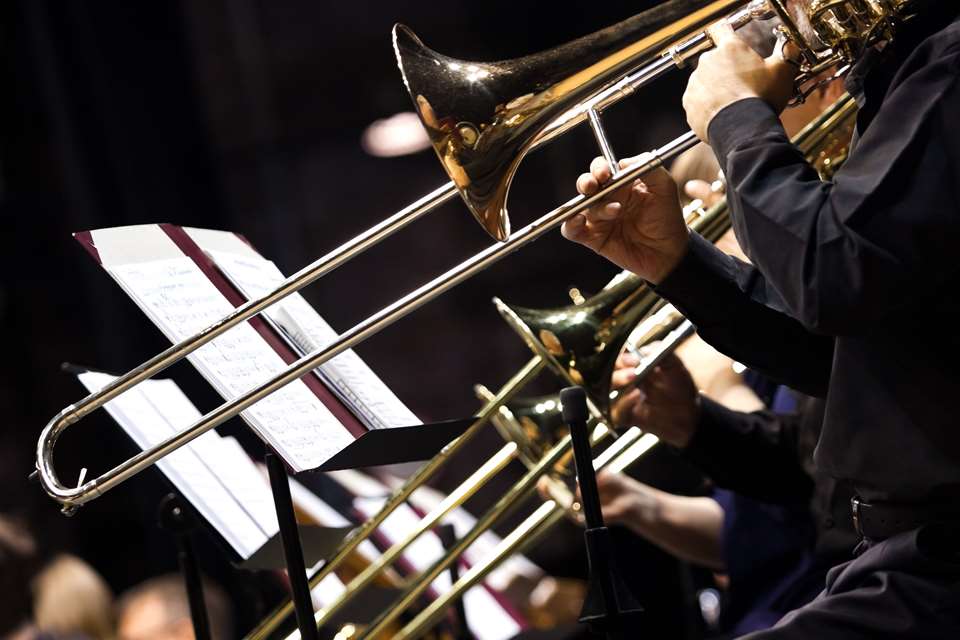Don't fear the French horn
Richard Steggall
Friday, December 1, 2023
French hornist and author Richard Steggall explains why brass teachers needn't shy away from the maverick of the family.

Adobe Stock / Stokkete
To the casual observer, the trombone appears to be the oddball of the brass section. Surely an instrument with a slide instead of valves is the odd one out? But ask a brass player which instrument they are most nervous about teaching, and 90% will come up with the same answer: the French horn.
But all brass instruments work in exactly the same way. They have been carefully designed so that when played ‘open’ (with no valves depressed) they can produce the notes of the harmonic series in the key of that instrument. The valves are identical: the second lowers the pitch by a semitone, the first by a tone, and the third by a tone-and-a-half. A mouthpiece is inserted at one end and sound waves magically radiate via a flared bell at the other. So far, so good.
There are other rules, however, that all brass instruments follow except the French horn. Most of these differences are historical. For example, you play the main three valves of all brass instruments with the right hand, except the French horn. Around 280 years ago, players of the natural horn (a circular instrument without valves) started using their right hand in the bell to change pitches. Around 1820, when the valve was invented and subsequently added to the horn, players still wanted to use their right hand to adjust pitch, so the valves were operated by the left hand. As the 19th century progressed and the right hand became stationary in the bell, the horn was already cemented as a left-handed instrument.
It is this period (from the playing of ‘natural’ instruments through the invention of the valve to the end of the 19th century) that helps us understand why the horn developed differently. If, for example, you look at the first or last movement of a Mozart symphony with two trumpets and two horns, you will notice that the parts for both instruments look very similar – they are in the key of the work and use the arpeggios occurring in the harmonic series. The horns played an octave lower than the trumpets, but to ensure enough notes were available for both instruments, ‘middle C’ was notated as the fourth harmonic. (NB. The placing of the harmonic series is the key to understanding the French horn.)
Brass players will notice that Mozart uses the bottom-line E, which you can't now play without valves on any treble-clef instrument … except one (I think you can probably guess which). That's because once the valve had been developed, the trumpet looked jealously at instruments such as the cornet, flugelhorn and tenor horn, and decided to shape up, lose some weight (well, at least some length) and join the new generation of brass instruments with middle C as the second harmonic. The invention of valves meant it no longer had to scrabble around in those treacherously close-together high harmonics.
The stubborn, traditionalist French horn, however, kept its ridiculously inefficient long tube and tiny mouthpiece for one main reason – to keep its wonderful sound. The instrument settled into being in the key of F, which seemed to be just right for a rich and noble tone. A slight concession was made in the second half of the 19th century, when some players started playing on a shorter B flat horn which gave more security and ease of playing in the upper register. There were drawbacks to this horn, however, as middle-register intonation could be quite troublesome and you couldn't hand-stop easily in tune, which led to the invention of the ‘double horn’ in 1887, combining both the F and B flat instruments.
Odd keys …
Most brass teachers will come across three different types of horn: the single F horn, the single B flat horn, and the F and B flat double horn (the trigger, or thumb valve, switching between each side). You can successfully teach young students on any of these instruments, although younger students (under-11s) will benefit from the lighter single horn, which can come in a ‘mini wrap’ or ‘Kinder horn’ design, making it easier for smaller pupils to hold.
There is much debate about which instrument is best to start on, and you may just have to cope with whatever instrument a pupil has, without having a choice. There are benefits to starting on the F horn but, because of the proximity of the notes in the harmonic series, it's better suited to those pupils that you know have a good ear. If in doubt about your pupil's musical abilities, start them on the B flat horn. If they have a double horn, choose which side to start on and stick with that for the first stages. The benefits of combining the two sides of the horn only come into play around Grade 3/4 and above.
… and odd fingerings
The fingerings on the F and B flat horns are different – and different to other brass instruments. Of course, you can just use a trusty fingering chart, but if you really understand our old friend the harmonic series, things become much clearer (and you'll also gain the trust of your pupils, as you won't need to constantly refer to a cheat sheet!).
If we look at the harmonic series in Figure 1, we can see that middle C is the second harmonic for treble-clef brass instruments; the fourth harmonic for the F horn; and the third harmonic for the B flat horn. The strangest looking one of these is probably the B flat horn, which is unique among beginner treble-clef brass instruments as the music is written in a different key to the instrument. If you take away nothing else from this article, remember this: all modern music for horn is written in F, irrespective of which key of instrument it's played on. Figure 1: Notes of the harmonic series. Courtesy Richard Steggall.
Figure 1: Notes of the harmonic series. Courtesy Richard Steggall.
So, how does a brass player work out the fingering on a French horn? You just need to match the harmonic on any other brass instrument. For example, if you are a trumpeter looking to teach the fingering of the C major scale (starting on middle C) for a pupil with an F horn, you know the first note is the fourth harmonic. Just start a scale on your fourth harmonic (third space) C, and you've found the correct fingering. The same scale on a B flat horn starts on the third harmonic, so start on the third harmonic on your instrument (second line G). If you are playing on a B flat instrument and match the harmonic of a B flat horn, you will not only match the fingering but also the pitch – but please remember the note names are different!
Hand position
For intermediate and advanced horn players, right-hand position is of great importance. The hand has five functions: support the weight of the horn; increase stability in the high register; help produce a good sound; easily move between open and hand-stopped; and adjust the horn's intonation. A bad position (for most students, a hand too far into the bell) can sabotage a pupil's hard work in other areas. Hand position can, therefore, seem rather daunting for a non-specialist horn teacher.
But teachers of beginner students needn't overly worry; there is another position that works just fine in the early stages of teaching. The beginner hand position is against the side of the bell nearest the player, whereas the more advanced position is touching the far side of the bell, as shown in Figure 2. Figure 2: Hand position for beginners (above) and advanced players (below). Courtesy Richard Steggall.
Figure 2: Hand position for beginners (above) and advanced players (below). Courtesy Richard Steggall.
Most beginners are a good height to play resting the horn on their thigh or chair when seated, so don't need the support of the right hand. Stability in the high register is not that relevant until they reach the Fat the top of the stave (around Grade 3/4) and most pupils won't need hand-stopping until around Grade 6. Intonation should initially be controlled by air and lips (like any other brass instrument), and the beginner hand position, although producing a tone that might be described as ‘bright’, is far preferable to jamming the hand into the bell!
So, like many aspects of teaching the horn, things aren't quite as complex and confusing as they might seem. A little understanding goes a long way, and your pupils will benefit greatly. Just don't fear the horn!
For a comprehensive guide to teaching the French horn, Richard Steggall's book Don't Fear the Horn is available from richardsteggall.co.uk
Music Teacher readers can receive 20% discount on the paperback and digital versions using the code MusicTeacher20




